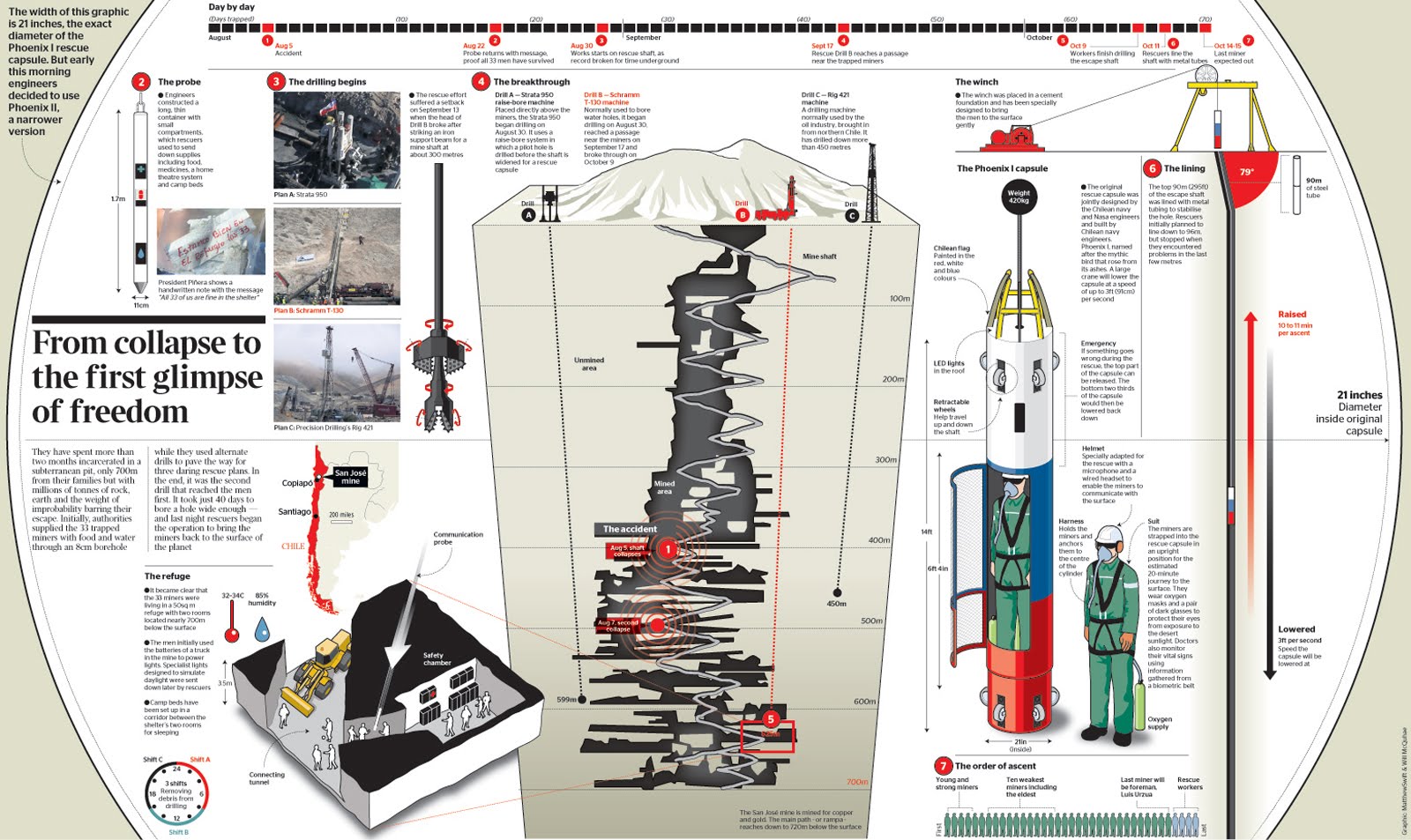The Chilean miners' rescue operation in 2010 remains one of the most remarkable survival stories in recent history. This incident not only showcased human resilience but also highlighted the significance of effective rescue strategies and international cooperation. The "Chilean miners diagram" serves as a visual representation of the rescue operation, illustrating the various stages and complexities involved in bringing the trapped miners to safety. In this article, we will explore the details of the rescue operation, the technology used, and the lessons learned from this incredible event.
In October 2010, 33 miners were trapped underground for 69 days at the San José copper-gold mine in Copiapó, Chile. The world watched as rescue teams worked tirelessly to reach the miners, using innovative techniques and equipment. The successful extraction of all 33 miners on October 13, 2010, was celebrated globally, symbolizing hope and perseverance in the face of adversity. This article aims to provide an in-depth look at the rescue operation through the lens of the Chilean miners diagram and analyze the factors that contributed to its success.
Throughout the following sections, we will delve into the timeline of events, the rescue methods employed, the roles of various organizations, and the impact of this operation on mining safety regulations worldwide. By examining these elements, we hope to offer readers a comprehensive understanding of the Chilean miners' rescue and its enduring significance.
Table of Contents
- Timeline of Events
- Rescue Methods Employed
- Organizations Involved
- Impact on Mining Safety Regulations
- Technological Advancements
- Psychological Effects on Miners
- Global Response and Media Coverage
- Lessons Learned from the Rescue
Timeline of Events
The timeline of the Chilean miners' rescue operation provides a chronological overview of the key events leading up to and during the rescue effort. The following points outline the critical moments:
- August 5, 2010: The miners become trapped 700 meters underground after a cave-in at the San José mine.
- August 22, 2010: Rescuers establish contact with the miners, confirming they are alive.
- September 2010: Drilling begins to reach the miners using a specialized drill called the “Plan B” drill.
- October 9, 2010: Rescuers break through to the miners after weeks of drilling.
- October 12, 2010: The first miner, Florencio Ávalos, is rescued, marking the beginning of a historic operation.
- October 13, 2010: All 33 miners are successfully rescued and brought to the surface.
Rescue Methods Employed
The rescue operation involved multiple methods and technologies to ensure the safe extraction of the miners. Key techniques included:
1. Drilling Techniques
Different drilling techniques were employed to create a tunnel large enough for the miners to be lifted to safety:
- Plan B Drill: A specialized drill designed for underground rescue operations.
- Rescue Capsule: A custom-built capsule known as "Phoenix" was used to transport miners to the surface.
2. Communication Systems
Maintaining communication with the trapped miners was vital for their morale and safety. The following systems were utilized:
- Emergency Radios: Radios were used to facilitate communication between the miners and the rescue teams.
- Video Conferencing: Video feeds allowed the miners to see and hear their families and rescuers.
Organizations Involved
The successful rescue operation was the result of collaboration among various organizations and agencies:
- Chilean Government: Led the overall rescue efforts and coordination.
- International Organizations: Various international teams offered expertise and support.
- Mining Experts: Engineers and mining specialists provided critical insights into safe drilling practices.
Impact on Mining Safety Regulations
The Chilean miners' rescue highlighted significant issues regarding mining safety and led to changes in regulations worldwide:
- Improved Safety Standards: The incident prompted many countries to reevaluate and enhance mining safety regulations.
- Emergency Preparedness: Mining companies worldwide began to develop more comprehensive emergency response plans.
Technological Advancements
The rescue operation showcased the importance of technology in emergency situations. Key advancements included:
- Advanced Drilling Equipment: Development of more efficient drilling technologies for rescue operations.
- Remote Monitoring Systems: Enhanced systems to monitor underground conditions in real-time.
Psychological Effects on Miners
The psychological impact of being trapped underground for 69 days was profound. Research indicates:
- Post-Traumatic Stress Disorder (PTSD): Many miners experienced symptoms of PTSD after their rescue.
- Support Systems: The importance of psychological support and counseling was emphasized for the miners post-rescue.
Global Response and Media Coverage
The global response to the Chilean miners' rescue was immense, with media coverage around the world:
- Live Broadcasts: Major news networks covered the rescue live, capturing the emotional moments of reunion.
- Public Support: People around the world expressed their support for the miners and their families.
Lessons Learned from the Rescue
The Chilean miners' rescue provided several key lessons for future emergency operations:
- Importance of Communication: Effective communication is crucial in any rescue operation.
- Collaboration is Key: Collaboration among various organizations enhances the likelihood of success.
Conclusion
In summary, the Chilean miners' rescue operation serves as a remarkable example of human determination and the power of collaboration. The "Chilean miners diagram" illustrates the complexity of the operation and the various methods employed to ensure the miners' safe return. As we reflect on this event, it is essential to recognize the ongoing importance of mining safety regulations and the need for preparedness in emergency situations. We invite readers to share their thoughts on this incredible story and explore more articles on similar topics.
Call to Action
If you found this article insightful, please leave a comment, share it with others, or check out our other articles for more engaging content!
Final Thoughts
Thank you for reading! We hope this article has provided you with valuable insights into the Chilean miners' rescue operation and its lasting impact. We look forward to seeing you again on our site for more informative articles.
Understanding Martin Attack: A Comprehensive Guide
How To Effectively Submit A Refund Request On PSN
The Truth Behind The Ugliest Celebrities: Beauty In Unconventionality


